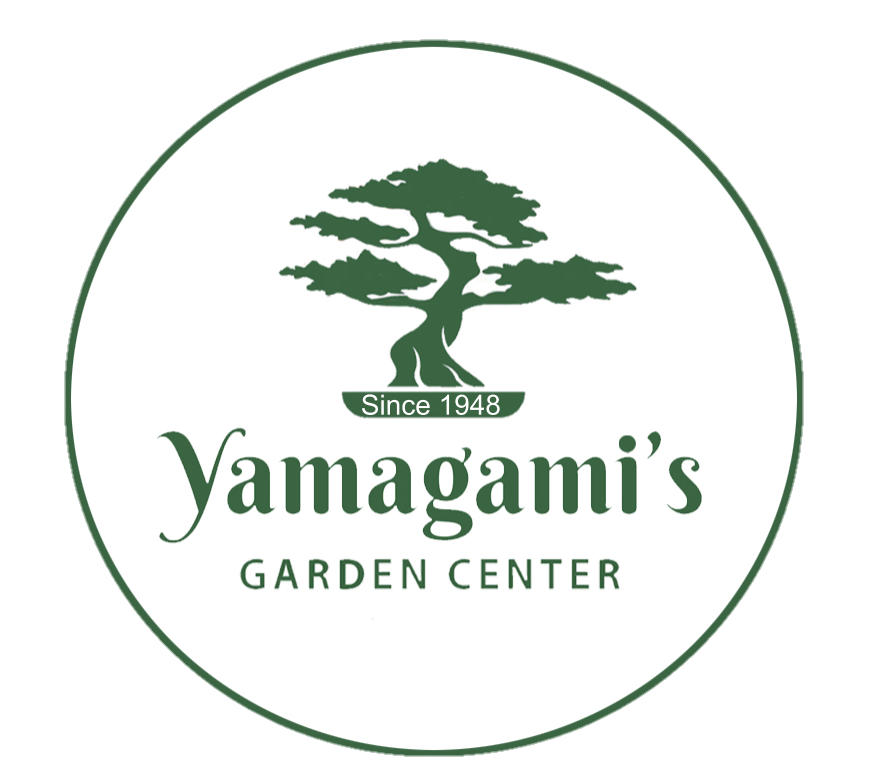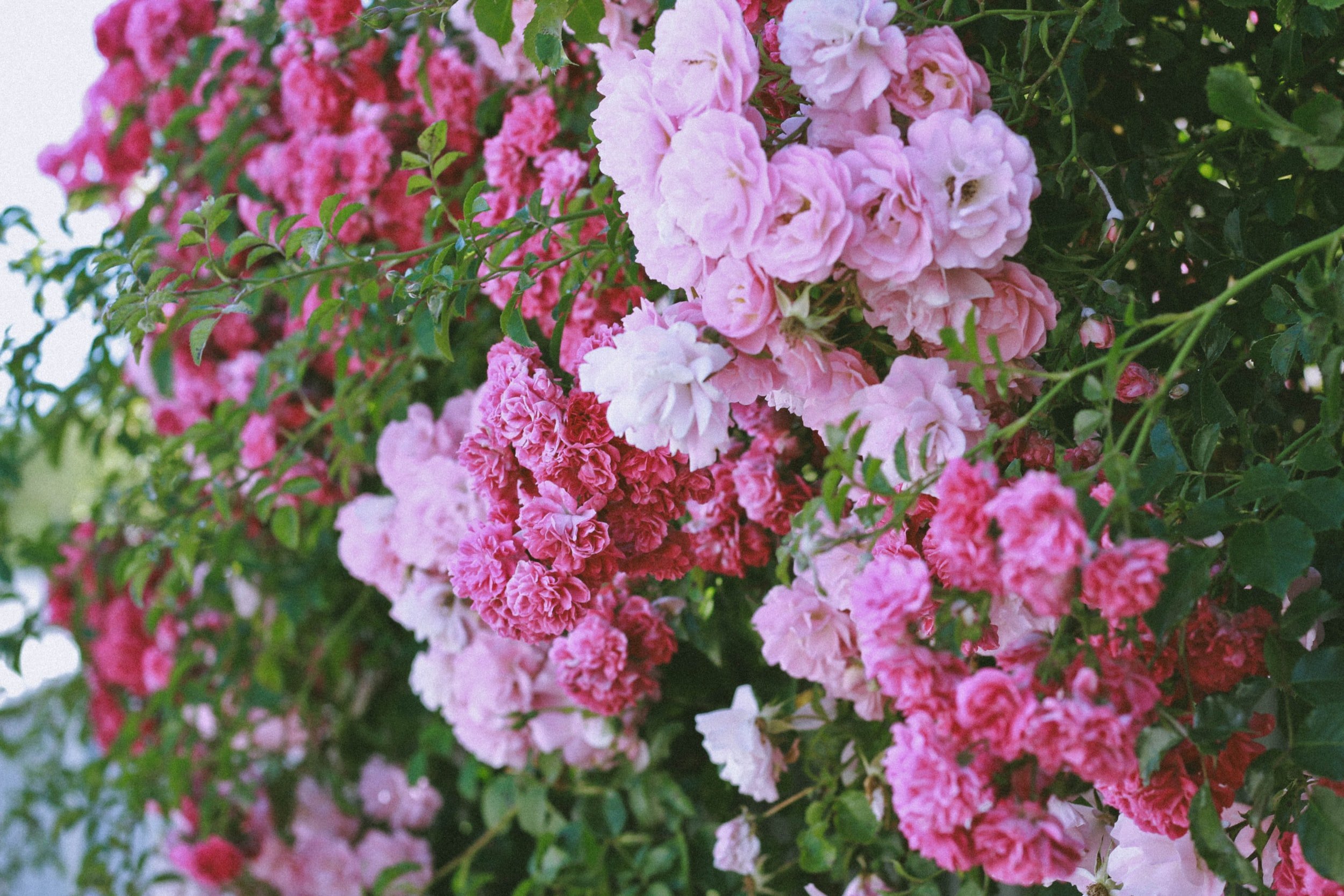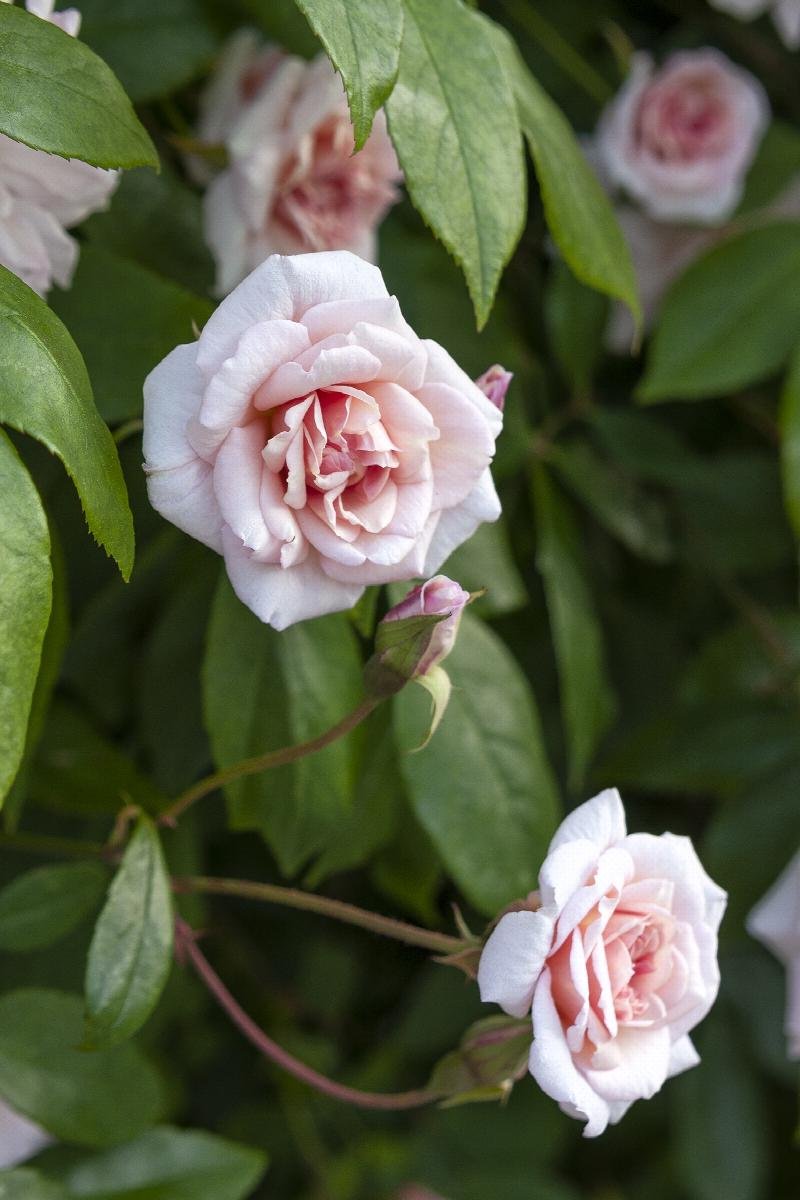Our Rose Selection & Care Guide
At Yamagami’s, we’re passionate about the beauty and versatility of roses, and we’re here to share our knowledge with you. We carry over 100 varieties at the nursery, ranging in size, shape, fragrance, and color so that our customers have plenty to choose from. From hybrid tea roses to tree roses, climbers to miniatures- you’ll find plenty of options for creating stunning displays and enjoying wonderful fragrances in your garden.
We’ll take a look at the different types of roses along with the bareroot rose varieties that we carry, and how roses can add that special touch to your garden.
Whether you’ve been growing roses for years or are just starting out, we have something for everyone to learn. Read on to discover all that roses have to offer!
Rose Types (Tree Roses, Climbing Roses, Bush Roses & Miniature Roses)
Tree Roses
Tree roses, also known as standards, are a popular garden rose variety characterized by their upright, tree-like shape. The stem of a tree rose is trained and grafted onto a short, woody trunk, giving it the appearance of a small tree.
Tree roses are a popular choice for gardeners because they are easy to care for and can provide a dramatic focal point in the garden. They are also relatively disease-resistant and require minimal pruning. With proper care, tree roses can be enjoyed for many years.
Tree roses can reach heights of up to 6 feet and come in many different varieties.
Our Tree Rose Recommendations:
A rare shade as a purple variety, ‘Celestial Night™’ is exceptionally productive and disease-resistant. Giant, double ruffled, plum-purple blooms give off a subtle fruity and spicy fragrance.
Named after ‘America’s Sweetheart’ Doris Day, this sunny yellow rose will make a lovely addition to your garden. With a fruity and spicy fragrance, this rose blooms in rounded clusters.
‘Double Delight’ is the most popular newcomer of the last 30 years. Fulfilling the two highest demands of the rose world – excellent color combination and wonderful fragrance – ‘Double Delight’ indeed is a delight for the senses. It has creamy blooms with a strawberry-red blush.
Climbing Roses
Despite its type name, climbing roses don’t actually “climb” like other plants that form tendrils and grasp onto nearby objects. Rather, climbing roses have extra long canes that you can secure to a wall or trellis.
If you dream of a cottage garden, climbing roses are essential.
Our Climbing Rose Recommendations:
The ‘Cecile Brunner’ is a climbing variety that produces clusters of pink, fragrant, double blooms throughout the summer. This variety is especially suited for walls and trellises because of its vigorous growth habit.
The ultimate dark red climbing rose, ‘Don Juan’ makes a statement with its fragrance and shapely blooms over glossy dark foliage. The best color comes with warm night temps.
Cheerful and sunny with apricot hues, ‘Golden Opportunity™’ has a delicious, fruity fragrance that attracts butterflies and other pollinators. This climbing rose creates charming cut flower arrangements as well.
‘White Dawn’ brings lightness and ease to any landscape. With abundant bright white flowers with ruffled petals, this vigorous disease-resistant climber is fast-growing and will readily blanket trellises and perfume your garden with its gardenia fragrance.
Eye-catching and very popular, the multicolored ‘Joseph’s Coat’ has bountiful clusters with lightly scented, double flowers that never seem to run out of color.
‘America’ is one of the few climbing roses to achieve an award. Free-flowering with coral pink blooms that exude a spicy fragrance, this climber is unusually vigorous and grows rapidly.
Lady In Red™ bears a true classic red hue throughout its entire bloom life, and is easier to contain and more compact compared to other climbing roses. Large, old-fashioned blossoms with ruffled edges are sure to invite romance into your garden.
Bush Roses (Hybrid Tea, Grandiflora, Floribunda & Miniature)
Hybrid Tea
Hybrid teas are the most popular type of rose. They belong to a category of roses that were created by cross-breeding Hybrid Perpetual and Tea roses.
Hybrid teas gained their popularity due to their large and colorful blooms. They’re highly fragrant and produce a range of colors and shapes. They’re also known for their resistance to disease and ability to survive in various climates.
Our Hybrid Tea Recommendations:
'Grande Dame™' is a classic hybrid tea rose with large, hot pink blooms and a sweet, spicy fragrance. It’s a robust bush that adds the finishing touch to a landscape or bouquet thanks to its enormous blooms (up to 6 inches in diameter), abundance of deep-green foliage, and low-thorned cutting stems.
We also have ‘Grande Dame™’ available as a Tree rose.
'Peace' is an award-winning, much beloved hybrid tea rose that was named to commemorate the end of World War II. With large, frilly lemony-yellow blooms with an apricot center, the edges are kissed with pink. The foliage is dark green and glossy, and the stems are nice and straight, making ‘Peace’ perfect as a cut flower.
'Fragrant Cloud' is another popular bush hybrid tea rose with large, fragrant blooms that are a deep salmon color. This robust rose bush has dark, glossy green foliage and produces many huge, shapely flowers.
'Mister Lincoln' is an award-winning hybrid tea rose with large, red blooms and is moderate and sweet in scent. It’s a vigorous grower and an excellent choice for creating a dramatic display in the garden.
When you think of a classic rose, it’s most likely that you picture ‘Firefighter®’ in your mind. It’s long-stemmed, richly red, and super fragrant to boot! The first sponsorship rose presented to the ‘Remember Me’ garden fund in honor of the victims of 9-11, ‘Firefighter’ holds deep meaning along with strong beauty. Cooler temperatures produce its finest shade of red.
‘Chantilly Cream™’ produces double flowers, creating a classic and old-fashioned vibe. Don’t let its light, yellow-shaded blooms fool you – this rose holds its own against scorching hot temps. Its strong, sweet citrus fragrance is guaranteed to please.
‘Chantilly Cream™’ is also available as a Tree rose.
'St. Patrick' is a striking hybrid tea rose with large, double blooms that are yellow and green in color. It has an upright growth habit and a light, sweet, citrusy fragrance. Add a bit of luck to your garden with this one!
Winner of several international awards, 'Sunset Celebration™' has all the hues of a sunset, including apricot, amber, orange, pink, peach. This hybrid tea rose has deep green foliage and medium-long stems. Cooler temperatures bring out deeper shades in the blooms, producing a moderate and fruity fragrance.
‘Chrysler Imperial’ is a landmark hybrid tea rose, mesmerizing people with its intoxicatingly intense fragrance and velvety red petals. Matte, dark green leaves grow below straight stems that hold the large, elegant blossoms. This rose is at its happiest in hot temperatures.
Until now, white roses have been known for their innocent beauty, but not so much for fragrance. ‘Sugar Moon™’ produces both beauty and perfume. Broad petals of pure white sit atop black-green leaves, which create gorgeous contrast. Reliable re-blooms and long cutting stems plus a strong, citrusy fragrance? Get that ‘Sugar’ in your garden!
Grandiflora
Another popular rose bush variety is the 'Grandiflora' rose. This type of rose bush is known for its large, fragrant flowers, which come in various colors. It has clusters of blooms on long stems, making them excellent for cut flowers. It’s also known for its ability to survive in various conditions and its hardiness in the garden.
Our Grandiflora Recommendations:
'Queen Elizabeth' is the first grandiflora rose that was developed. Characterized by large, silver-pink blooms and a moderate, sweet fragrance, this rose is sure to make a regal addition to any garden.
Watching a ‘Dick Clark’ rose bloom is a showy display of colors to behold. Starting off as a black-red bud, it spirals open into a swirl of cream which is then washed over with a vibrant cherry pink. When the sunlight hits the blossom, the petals blush burgundy, concluding this mesmerizing production with a deep blood red.
Opulent in its gold and pink petals as well as its spicy fragrance, you’re bound to strike gold in your garden with ‘Strike It RichⓇ’. Dark green foliage and unusual red stems create the backdrop for the abundant clusters of blooms.
Named after the beloved American icon, ‘Julia Child’ will win over your heart just the same. Buttery gold blossoms with a licorice candy fragrance against glossy green foliage, this award-winning grandiflora is very disease-resistant and consistent.
Alluring and mysterious, ‘Twilight Zone’ is absolutely captivating for the senses. Scented with clove and zesty citrus, the smokey purple blossoms sit atop deep green leaves. It’s guaranteed to spin the heads of passersby.
Floribunda
The 'Floribunda' rose is a cross between polyantha species and hybrid tea roses. It’s a popular choice due to its hardiness and ability to produce free flowering, showy, and fragrant blooms. This variety is known for its compact and low-growing habit, making them ideal for tall hedges.
Our Floribunda Recommendations:
The allure of ‘White Licorice™’ is undeniable: the delicate lemon-yellow color and its candy perfume of licorice and lemon blossom. In warmer temperatures, the color appears more ivory whereas in cooler temperatures it’s more yellow.
Named to honor American glass artist Dale Chihuly, ‘Chihuly®’ is a true art display. When the sun hits the lightly scented blossoms, they blush from apricot to orange and deep red, revealing a yellow center. The deep dark green foliage provide beautiful contrast with the blooms.
Mysterious and romantic, ‘Hot Cocoa™’ starts off with dark rust which then opens to reveal smoky chocolate shades with a purple cast on ruffled petals. It’s vigorous and disease-resistant with a light tea fragrance.
With hot pink edges with a yellow center, ‘Sheila’s Perfume’ is a sight to enjoy as well as a rose to bury your nose in. The scent is so special that it won the Royal National Rose Society’s Edland Medal for fragrance. Though classified as a Floribunda, the flower size and form are more similar to a Hybrid Tea.
In all its striped glory, ‘Scentimental™’ is sure to bring whimsy and interest to your garden. Burgundy and cream stripes make each petal unique and appear as if the spicy-scented blossoms were painted.
This exceptionally fragrant, deep yellow Floribunda is sure to bring smiles. ‘Sunsprite’ is very disease-resistant and long-lasting, making it one of the most popular garden roses.
If you want a truly special rose to grow, look no further. Each petal on ‘Purple Tiger’ is distinctive from the other, splashed with purple, lavender, white stripes, streaks, and flecks. The blossoms exude a citrus blossom fragrance. Compared to other roses, ‘Purple Tiger’ is a bit high-maintenance, but very much worth the extra effort.
‘Drop Dead Red™’ is so intensely red, it will stop you dead in your tracks. Showy and absolutely gorgeous, the flowers remain this deep, velvety red shade throughout its entire bloom life. The flower size grows with cooler temperatures.
‘Drop Dead Red™’ is also available as a Tree rose.
Miniature Roses
Miniature roses have been bred to remain small in size with smaller flowers compared to standard rose bushes. However, they still have the same types and colors as standards. Miniature roses are very hardy.
Our Miniature Rose Recommendations:
If you’re into all things miniature and cutesy, ‘Tiddly Winks™’ is your rose. Don’t let the child-like name fool you – ‘Tiddly Winks’ is a work horse, producing clusters upon clusters of double blooms. The deep gold buds unfurl into orange-pink with a yellow center. Round and compact, this miniature rose is perfect for containers.
‘Lava Flow’ creates a blanket of deep red color with its long-lasting ruffled flowers in large tight clusters. Its dark green foliage provides a beautiful backdrop for the perpetual flow of red blooms.
Bareroot Rose Care
The Basics
Sun
Roses need at least 6 hours of sunlight to perform their best. An ideal spot for roses are where they’ll receive lots of morning sunshine.
Soil
Roses prefer rich, sandy soil with excellent drainage (G&B Organics Rose Flower Planting Mix is an excellent option). If you have clay soil, amend it with G&B Organics Soil Building Conditioner.
Roses also thrive in containers. If you plan on potting them up, your roses will be very happy in G&B Organics Potting Soil.
Spacing
Prevent disease and root competition by leaving ample space between your roses and other shrubs and trees.
Irrigation
Roses enjoy a slow, deep soak. Keep in mind, sandy soils require more watering than clay soils.
Mulching
Mulching is a great idea if you want to conserve water, discourage weeds, and invite earthworms.
G&B Organics Soil Building Conditioner not only amends soil, but it also acts as an excellent top mulch. Adding a 3-inch layer to the top of your soil will reduce watering needs by 30%.
Fertilization
New rose plants don’t require fertilization until they grow about 4 to 6 inches. When you begin to fertilize, use G&B Organics Rose & Flower Fertilizer (4-6-2), but only half the strength that’s recommended on the package. Increase to full strength as the rose matures.
Fertilizer after each blooming cycle, and stop feeding before winter.
Pruning
Removing spent blooms will encourage more flowers. In early spring, prune back hard after the frost has passed but before new growth appears.





































